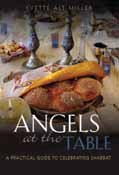Angels at the Table: A Practical Guide to Celebrating Shabbat
Angels at the Table: A Practical Guide to Celebrating Shabbat
By Yvette Alt Miller
Continuum
New York, 2011
367 pp. + vii
Reviewed by Hillel Goldberg
 After I read Abraham Joshua Heschel’s beautifully written and spiritually penetrating The Sabbath, with its elaboration of Shabbat as a “palace in time,” I thought I had read everything I needed in order to grasp the thought behind the halachot of Shabbat.
After I read Abraham Joshua Heschel’s beautifully written and spiritually penetrating The Sabbath, with its elaboration of Shabbat as a “palace in time,” I thought I had read everything I needed in order to grasp the thought behind the halachot of Shabbat.
Then I read Dayan Grunfeld’s short, lucid, penetrating The Sabbath: A Guide to its Understanding and Observance, which defines the intimate relationship between the serenity (menuchah) of Shabbat and the halachot of the Tabernacle (Mishkan). I thought, now, finally, I have what I need to grasp the thought behind the structure of the thirty-nine forbidden labors of Shabbat (lamed tet melachot).
With Heschel and Grunfeld under my belt, I was set.
Then I read Shimshon Dovid Pincus’ enchanting Shabbos Kodesh: Making the Most of Shabbos, and I saw that alongside the halachically grounded spirituality of Shabbat, I needed to address more practical issues that potentially can rob the Sabbath observer of an unadulterated, spiritual observance of Shabbat. What does one do for children on long Shabbat summer afternoons, for example? Endlessly informed and encouraged by Pincus’ “inspiring insights into the meaning and purpose of Shabbat,” I thought, finally, I have what I need.
Then I became aware of another book, Angels at the Table: A Practical Guide to Celebrating Shabbat, by Yvette Alt Miller. I learned that my search for the meaning of Shabbat was still incomplete. The truth is, how could it be otherwise? If Shabbat is the Jew’s closest, steadiest, and most enticing connection to the Holy One, Blessed be He, and if the Holy One is infinite, then there will never be an exhaustive philosophy of, halachic deep structure of, or practical guide to Shabbat. The Author of Shabbat is infinite; the blessing of Shabbat is endless in its meaning in every age.
Miller’s Angels at the Table brings Shabbat observance into contemporary times by addressing questions that Heschel, Grunfeld and even Pincus did not dream of. For example: You are single and live in an apartment. Or you are a ba’al teshuvah. The palace in time finds you without family, a major framework for living the Divine gift of Shabbat. How do you access the deep serenity of Shabbat? This is the kind of question that Miller addresses. Her answers are anything but theoretical. She herself was single for many years; she conveys the spiritual devices that she and her friends devised to access Shabbat no less than families. Her book is, to an extent, autobiographical, openly and honestly exploring both the impetus and obstacles to Sabbath observance.
Miller’s book is written in part for a person just coming into Sabbath observance and in part for a person not even contemplating Sabbath observance. Miller addresses the ba’al teshuvah and the not-yet ba’al teshuvah. Thus, she includes everything from recipes for Shabbat foods to a summary of all fifty-four Torah portions that a not-yet Jewishly literate seeker will need to know.
Miller manages to be an upfront, straightforward advocate of Shabbat observance without being preachy. She is militant in her projection of Sabbath observance as spiritually indispensable for every Jew—marshaling arguments, countering prejudices, explaining practices easily mocked by outsiders (i.e., by her potential insiders)—and she is gentle, understanding, convincing and empty of apologetics. Modesty in dress, coming late to shul, the relative merits of different zemirot—matters both major and minor that any lifetime or longtime Sabbath observer takes for granted, Miller takes seriously. Her idiom is 21st-century. No lyrics a la Heschel, no halachic precision a la Grunfeld, no mystical flights a la Pincus. Just very direct, very honest, spiritual sensitivity:
I remember a turning point vividly: a friend was visiting and she dropped her contact lens in a dark room. Now, turning on an electric light is a violation of Shabbat, but as my guest fumbled for her lens, I switched on the overhead light—the first time I had done so on Shabbat in years. This was a well-meaning gesture, but as my hand flipped the switch, I felt as if I was wrecking something precious and rare with it. For keeping Shabbat is a deliberate decision we make: once it is shattered it can only be put back together again through our own concentration and resolve. Shabbat is in essence a magical, transformative experience, and if you do not imbue it with transformative meaning, you cannot fully accept its magic. The Torah teaches us that on Shabbat every Jew acquires an additional soul; in the years that I did not fully observe Shabbat, I felt that I never opened myself to fully accept that special Shabbat spirit, and felt unaccustomedly alone.
It would be a bit arrogant for a regular Shabbat observer to dismiss Miller’s book, it is for the ba’al teshuvah, not for me. Her book is for the ba’al teshuvah; but, like any genuine exploration of Shabbat, her book contains tremendous value for anyone seeking to grow in his or her Shabbat observance. Her approach is refreshing, her angels at the table almost palpable.
Rabbi Hillel Goldberg, executive editor of the Intermountain Jewish News, is a contributing editor of Jewish Action.
